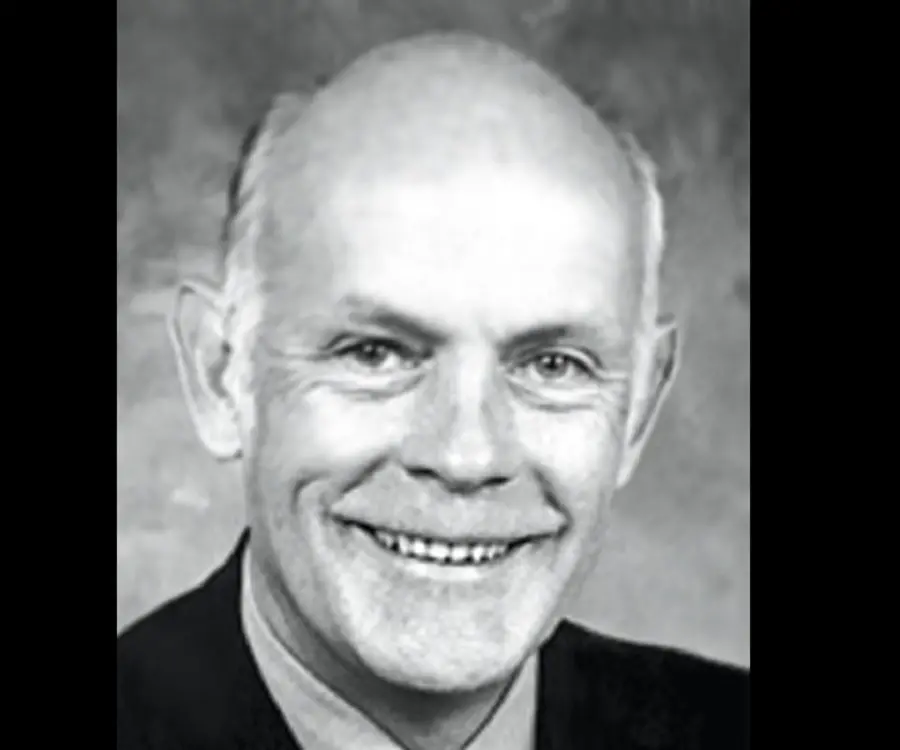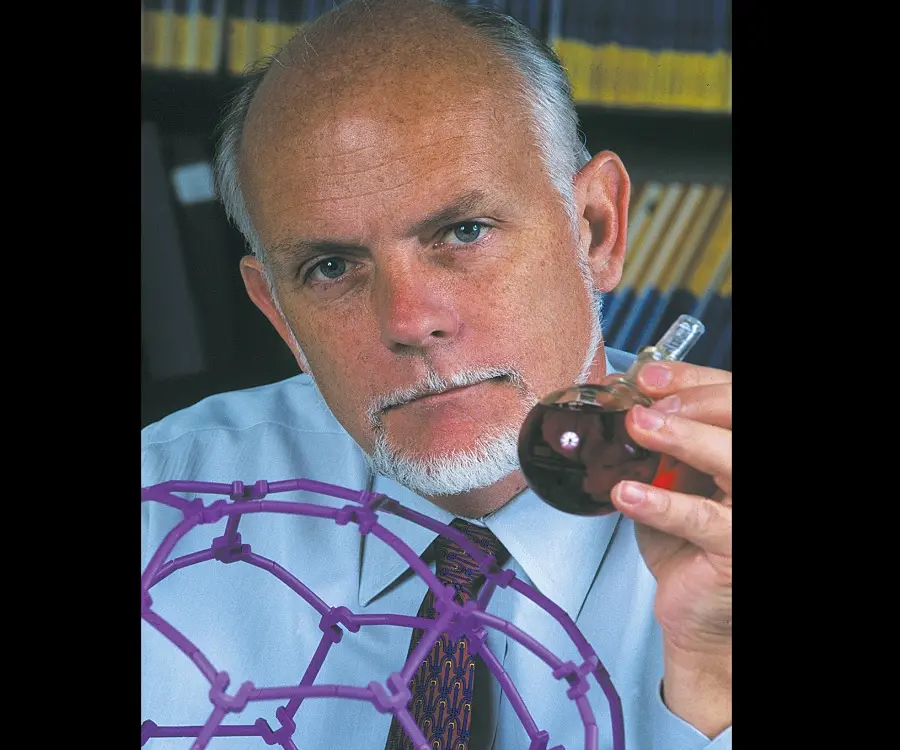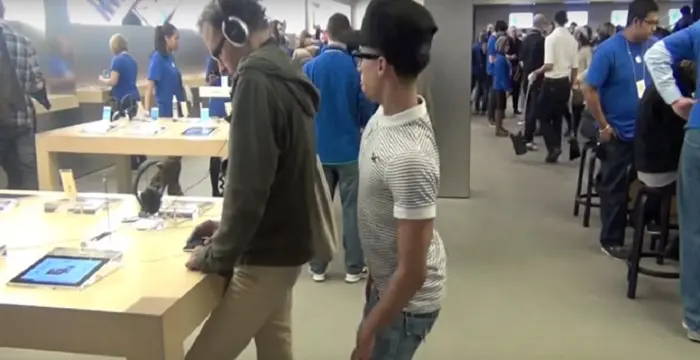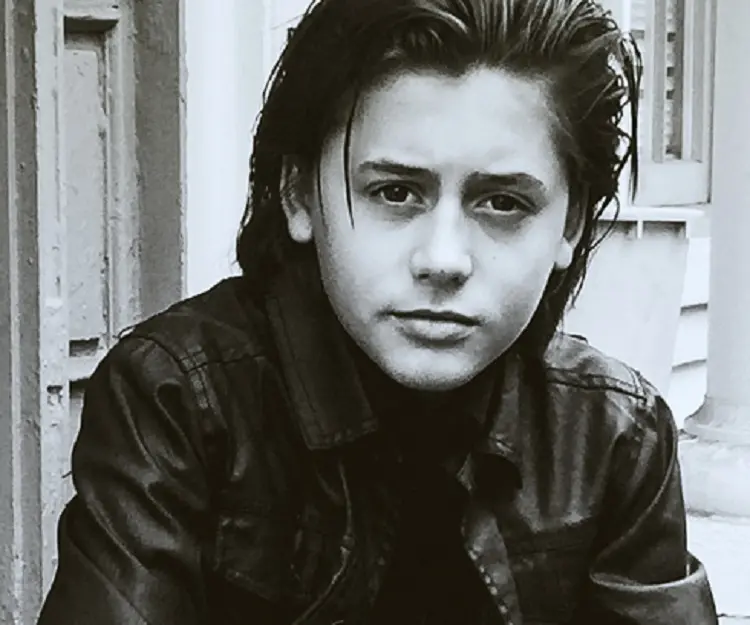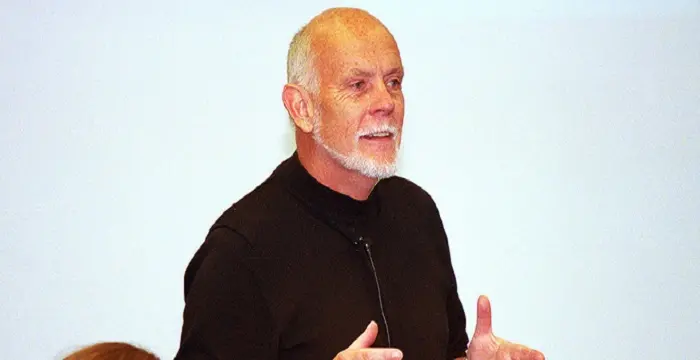
Richard E. Smalley - Father of Nanotechnology, Facts and Life
Richard E. Smalley's Personal Details
Richard Errette Smalley was a renowned American chemist who won the 1996 Nobel Prize in Chemistry
| Information | Detail |
|---|---|
| Birthday | June 6, 1943 |
| Died on | October 28, 2005 |
| Nationality | American |
| Famous | Scientists, Chemists, Father of Nanotechnology |
| Birth Place | Ohio, United States |
| Gender | Male |
| Sun Sign | Gemini |
| Born in | Ohio, United States |
| Famous as | Father of Nanotechnology |
| Died at Age | 62 |
Richard E. Smalley's photo
Who is Richard E. Smalley?
Richard Errette Smalley was a renowned American chemist who won the 1996 Nobel Prize in Chemistry for the discovery of a new form of carbon, Buckminsterfullerene. Considered to be an authority in cluster chemistry and cold ion beam technology, he was the Gene and Norman Hackerman Professor of Chemistry and a Professor of Physics and Astronomy at Rice University, USA. Born in early 1940s in Ohio, but brought up in Kansas City, he had his first lessons in science sitting on his mother’s lap. However, it was his maternal aunt, Dr. Sara Jane Rhoads, who mostly influenced him to take up chemistry. Subsequently, he earned his bachelor’s degree in chemistry from the University of Michigan and his PhD from the University of Princeton. In between, he worked for few years as a chemist at the Shell Company. Later he did his post doctorate at Chicago University. After completion of the term, he joined Rice University at Houston. There he worked with Professor Curl and Professor Kroto, and the trio made the Nobel Prize winning discovery of buckminsterfullerene. Later, he conducted extensive research into nanotube single-crystal growth, and was a leading advocate of nanotechnology. It was partly because of him that the Federal Government formed the National Nanotechnology Initiative in early 2000s.
// Famous Chemists
Henry Cavendish
Henry Cavendish was a theoretical chemist and physicist, renowned for discovery of hydrogen and calculation of the mass of earth. To know more about his childhood, profile, timeline and career read on
Walter Kohn
Nobel Laureate Walter Kohn was an Austrian-born American theoretical chemist and physicist. Check out this biography to know about his childhood, life, achievements, works & timeline.
Jabir Ibn Hayyan
Jabir Ibn Hayyan was a medieval era polymath. Check out this biography to know about his life, works and achievements.
Childhood & Early Life
Richard Errette Smalley was born on June 6, 1943, in Akron, Ohio into a close-knit family with Midwestern values. His father, Frank Dudley Smalley Jr, was a self-made industrious man, equally dedicated to his family. Starting his career as a carpenter he retired as the CEO of several trade journals.
His mother, Esther Virginia (nee Rhoads), named him after the English king Richard the Lion Hearted; but as she was a good American, she always called him ‘Mr. President’. She was an extraordinary woman, who earned her bachelor’s degree when Richard was in his teens.
Edward was the youngest of his parents’ four children and possibly the most favorite. The three elder siblings were Clayton, Mary Jill and Linda. The family settled in the Kansas City, Missouri when Richard turned three.
At Kansas City, he spent hours collecting single celled organisms from the local pond and watching them under a microscope with his mother. She also taught him about music, painting, sculpture, architecture and mechanical drawing. From his father, he learned to build things and to fix mechanical and electronic equipments.
When the time came, he was admitted to the Southwest High School. The most significant event during this period was the launch of Sputnik in 1957. Although the incident aroused in him an interest in science, he was still an erratic student.
In 1959, he was introduced to chemistry for the first time. Suddenly he became serious student and spent a lot time cooped up in the attic, preparing lessons. Although he also liked physics, chemistry was his first love.
Another important influence in his choice of subject was his mother’s younger sister, Dr. Sara Jane Rhoads. She was a professor of chemistry and one of the first women to become a full professor in the U.S.A.
Robert spent the summer of 1961 working in Dr. Rhoads laboratory; an experience, which drew him closer to chemistry. In fall, he graduated from school and on her suggestion, entered Hope College (in Holland, Michigan) with chemistry.
However, after two years at Hope College, Robert Smalley shifted to University of Michigan and in 1965 earned his Bachelor of Science degree from there. He then joined a polypropylene manufacturing plant owned by Shell Chemical Company in Woodbury as chemist and was assigned to the quality control laboratory.
The two years at the laboratory were a broadening experience for Smalley. Thereafter he was shifted to the Plastic Technical Center at the same site. Here he worked on developing analytical methods for various aspects of polyolefins.
Although he enjoyed working at Shell he soon realized that it was time to start his graduate work. Therefore, he joined the Princeton University in the fall of 1969 and started working with Elliot R. Bernstein on 1,3,5-triazine, a heterocyclic benzene analog, earning his PhD in 1973.
Career
In 1973, even before he actually defended his thesis and received his Ph.D., Smalley joined the University of Chicago as postdoctoral fellow. Here, he worked with Donald H. Levy and Lennard Wharton to develop a supersonic beam laser spectroscopy.
Meanwhile, at Rice University in Houston, Robert F. Curl had made significant progress in laser spectroscopy. Smalley now wanted to collaborate with him and therefore, after the completion of postdoctoral work, he joined Rice in the summer of 1976 as an Assistant Professor.
Here too he set up a laser supersonic cluster beam apparatus, but it was adapted to use pulsed dye lasers in the ultraviolet. With it they could study more ordinary molecules such as benzene. Concurrently, Smalley worked to set up the Rice Quantum Institute, which was officially established in 1979.
In 1982, he was named the Gene and Norman Hackerman Professor in Chemistry. Along with teaching he kept on his research work and continued improving his apparatus.
Sometime in the early 1980s, after intense research work, his team found a way to use a pulsed laser, directed into a nozzle, to vaporize any material. Moreover, it could now be used to study the properties of nanometer scale particles, which consist of precise number of atoms.
Professor Curl was highly impressed by Smalley’s apparatus and soon the two scientists began working on semiconductors like silicon and germanium with it. Simultaneously, in the University of Sussex, Professor Harold W. Kroto was working on astronomical dust formed by carbon-rich grains expelled by old stars like R Coronae Borealis.
Kroto now wanted to see how carbon chains, found in the dusts, were formed. On being informed about Smalley’s apparatus, he traveled to Houston towards the end of 1985.
At Rice University, Curl, Kroto and Smalley began their collaboration. Along with their graduate students James Heath, Yuan Liu, and Sean O’Brien, the three scientists began exposing graphite surface to laser pulses.
They did find the long carbon chains they were looking for; but unexpectedly they also found carbon molecules with 60 and 70 atoms. On further probe, they found C60 were more common. It was a hitherto unknown substance.
Therefore, they began to investigate on it. Within eleven days, they established that the molecule is one nanometer (one-billionth of a meter) in size and its atomic arrangement resembles two conjoined geodesic domes. Subsequently, they called it Buckminsterfullerene, after Buckminster Fuller, the American architect, who invented geodesic dome.
In 1986, Smalley was selected as the Chairman of the Rice Quantum Institute. Concurrently, he continued to work on nanotechnology. He strongly believed that only nanotechnology could solve the most pressing problems of the earth, especially the need for clean energy and water.
In 1990, he also became a Professor in the Department of Physics at Rice, a post he held concurrently with that of Professor of Chemistry at the same university. At the same time, he began to work for establishing the Center for Nanoscale Science and Technology.
In 1996,, he gave up the Chairmanship of Rice Quantum Institute and became the Director of Center for Nanoscale Science and Technology, a position he held until 2001. Subsequently from 2001 to 2005, he was the Director of Carbon Nanotechnology Laboratory, also at Rice.
Major Works
Smalley is best remembered for his creation of the laser supersonic cluster beam apparatus and subsequent discovery of the third allotropic formation of carbon, called the Buckminsterfullerene or ‘buckyballs’. Until then, graphite and diamond were the only two known allotropes of carbon.
The discovery opened a new field of research called fullerene chemistry and contributed significantly to the development of nanotechnology. Later he also became the leading advocate of this technology. It was partly because of him that the National Nanotechnology Initiative; a United States federal government program, was established in 2003.
Awards & Achievements
In 1996, Richard Smalley received the Nobel Prize in Chemistry jointly with Curl and Kroto “for their discovery of fullerene”.
Apart from Nobel Prize, he also received numerous other prizes such as Irving Langmuir Award (1991), E. O. Lawrence Memorial Award (1992), APS International Prize for New Materials (1992),Franklin Medal, The Franklin Institute (1996), American Carbon Society Medal (1997) etc.
He was also elected Fellow of the American Physical Society (1987) and Fellow of the American Association for the Advancement of Science, 2003.
Personal Life & Legacy
Richard Smalley was married four times. On May 4, 1968, he married Judith Grace Sampieri. They had a son named Chad Richard Smalley, born on June 8, 1969. The marriage broke up in 1978.
From 1980 to 1994, he was married to Mary L. Chapieski.
In 1997, he married JoNell Chauvin, with whom he had a son, Preston Reed Smalley. His third marriage ended in 1998.
Thereafter, he tied the knot with Deborah Lynn Sheffield Smalley. The couple remained married until his death in 2005. From this marriage he had two stepdaughters; Eva Kluber and Alison Kluber.
In 1999, Smalley was diagnosed with cancer. In spite of chemotherapy and ever-progressing disease, he kept on promoting nanotechnology and in 2003 testified before the U.S. House of Representatives in support of the National Nanotechnology Initiative.
He died from leukemia on October 28, 2005 at M.D. Anderson Cancer Center in Houston, Texas, at the age of 62.
In the same year, Center for Nanoscale Science and Technology (CNST) that he helped to build was renamed as The Richard E. Smalley Institute for Nanoscale Science and Technology. Later it was merged with the Rice Quantum Institute and is now called Smalley-Curl Institute (SCI).
In 2015, the US Senate passed a resolution crediting Smalley as the “Father of Nanotechnology”.
// Famous Scientists
Juliane Koepcke
Juliane Koepcke is a German-Peruvian biologist, who was the lone survivor among the 92 passengers and crew of the ill-fated LANSA Flight 508 that crashed in the Peruvian rainforest on 24 December 1971. Know more about her life in this biography.
Henry Cavendish
Henry Cavendish was a theoretical chemist and physicist, renowned for discovery of hydrogen and calculation of the mass of earth. To know more about his childhood, profile, timeline and career read on
Konstantin Tsiolkovsky
Konstantin Tsiolkovsky was a Russian rocket scientist and a pioneer of astronautics. This biography provides detailed information about his childhood, family, personal life, career, achievements, etc.
Richard E. Smalley's awards
| Year | Name | Award |
|---|---|---|
Other | ||
| 0 | 1996 - Nobel Prize in Chemistry | |
| 0 | John Scott Legacy Medal and Premium | |
Richard E. Smalley biography timelines
- // 6th Jun 1943Richard Errette Smalley was born on June 6, 1943, in Akron, Ohio into a close-knit family with Midwestern values. His father, Frank Dudley Smalley Jr, was a self-made industrious man, equally dedicated to his family. Starting his career as a carpenter he retired as the CEO of several trade journals.
- // 1957When the time came, he was admitted to the Southwest High School. The most significant event during this period was the launch of Sputnik in 1957. Although the incident aroused in him an interest in science, he was still an erratic student.
- // 1959In 1959, he was introduced to chemistry for the first time. Suddenly he became serious student and spent a lot time cooped up in the attic, preparing lessons. Although he also liked physics, chemistry was his first love.
- // 1961Robert spent the summer of 1961 working in Dr. Rhoads laboratory; an experience, which drew him closer to chemistry. In fall, he graduated from school and on her suggestion, entered Hope College (in Holland, Michigan) with chemistry.
- // 1965However, after two years at Hope College, Robert Smalley shifted to University of Michigan and in 1965 earned his Bachelor of Science degree from there. He then joined a polypropylene manufacturing plant owned by Shell Chemical Company in Woodbury as chemist and was assigned to the quality control laboratory.
- // 1969 To 1973Although he enjoyed working at Shell he soon realized that it was time to start his graduate work. Therefore, he joined the Princeton University in the fall of 1969 and started working with Elliot R. Bernstein on 1,3,5-triazine, a heterocyclic benzene analog, earning his PhD in 1973.
- // 1973In 1973, even before he actually defended his thesis and received his Ph.D., Smalley joined the University of Chicago as postdoctoral fellow. Here, he worked with Donald H. Levy and Lennard Wharton to develop a supersonic beam laser spectroscopy.
- // 1976Meanwhile, at Rice University in Houston, Robert F. Curl had made significant progress in laser spectroscopy. Smalley now wanted to collaborate with him and therefore, after the completion of postdoctoral work, he joined Rice in the summer of 1976 as an Assistant Professor.
- // 1979Here too he set up a laser supersonic cluster beam apparatus, but it was adapted to use pulsed dye lasers in the ultraviolet. With it they could study more ordinary molecules such as benzene. Concurrently, Smalley worked to set up the Rice Quantum Institute, which was officially established in 1979.
- // 1980 To 1994From 1980 to 1994, he was married to Mary L. Chapieski.
- // 1982In 1982, he was named the Gene and Norman Hackerman Professor in Chemistry. Along with teaching he kept on his research work and continued improving his apparatus.
- // 1985Kroto now wanted to see how carbon chains, found in the dusts, were formed. On being informed about Smalley’s apparatus, he traveled to Houston towards the end of 1985.
- // 1986In 1986, Smalley was selected as the Chairman of the Rice Quantum Institute. Concurrently, he continued to work on nanotechnology. He strongly believed that only nanotechnology could solve the most pressing problems of the earth, especially the need for clean energy and water.
- // 1987 To 2003He was also elected Fellow of the American Physical Society (1987) and Fellow of the American Association for the Advancement of Science, 2003.
- // 1990In 1990, he also became a Professor in the Department of Physics at Rice, a post he held concurrently with that of Professor of Chemistry at the same university. At the same time, he began to work for establishing the Center for Nanoscale Science and Technology.
- // 1996In 1996,, he gave up the Chairmanship of Rice Quantum Institute and became the Director of Center for Nanoscale Science and Technology, a position he held until 2001. Subsequently from 2001 to 2005, he was the Director of Carbon Nanotechnology Laboratory, also at Rice.
- // 1996In 1996, Richard Smalley received the Nobel Prize in Chemistry jointly with Curl and Kroto “for their discovery of fullerene”.
- // 1997 To 1998In 1997, he married JoNell Chauvin, with whom he had a son, Preston Reed Smalley. His third marriage ended in 1998.
- // 1999 To 2003In 1999, Smalley was diagnosed with cancer. In spite of chemotherapy and ever-progressing disease, he kept on promoting nanotechnology and in 2003 testified before the U.S. House of Representatives in support of the National Nanotechnology Initiative.
- // 2003The discovery opened a new field of research called fullerene chemistry and contributed significantly to the development of nanotechnology. Later he also became the leading advocate of this technology. It was partly because of him that the National Nanotechnology Initiative; a United States federal government program, was established in 2003.
- // 2005Thereafter, he tied the knot with Deborah Lynn Sheffield Smalley. The couple remained married until his death in 2005. From this marriage he had two stepdaughters; Eva Kluber and Alison Kluber.
- // 28th Oct 2005He died from leukemia on October 28, 2005 at M.D. Anderson Cancer Center in Houston, Texas, at the age of 62.
- // 2015In 2015, the US Senate passed a resolution crediting Smalley as the “Father of Nanotechnology”.
// Famous Gemini Celebrities peoples
Wentworth Miller
Wentworth Miller is an American actor and screenwriter who achieved recognition for his role in the TV series ‘Prison Break’.
Joyce Meyer
Joyce Meyer is a Christian author and speaker. This biography provides detailed information about her childhood, life, achievements, works & timeline
Zoe LaVerne
Zoe LaVerne is an American musical.ly star. Check out this biography to know more about her family, personal life, including her age, birthday, etc.
WolfieRaps
Check out all that you wanted to know about WolfieRaps, the famous YouTube Personality; his birthday, his family and personal life, his girlfriends, fun trivia facts and more.
Adam Saleh
Check out all that you wanted to know about Adam Saleh, the famous YouTube Personality; his birthday, his family and personal life, his girlfriends, fun trivia facts and more.
Isaak Presley
All about American actor and singer Isaak Presley including his age, birthday, family life, girlfriends, net worth, and some fun facts.
Richard E. Smalley's FAQ
What is Richard E. Smalley birthday?
Richard E. Smalley was born at 1943-06-06
When was Richard E. Smalley died?
Richard E. Smalley was died at 2005-10-28
Which age was Richard E. Smalley died?
Richard E. Smalley was died at age 62
Where is Richard E. Smalley's birth place?
Richard E. Smalley was born in Ohio, United States
What is Richard E. Smalley nationalities?
Richard E. Smalley's nationalities is American
What is Richard E. Smalley's sun sign?
Richard E. Smalley is Gemini
How famous is Richard E. Smalley?
Richard E. Smalley is famouse as Father of Nanotechnology

